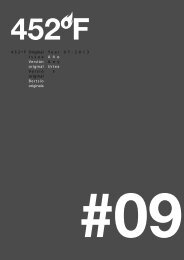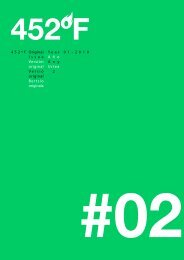03 - 452ºF
03 - 452ºF
03 - 452ºF
You also want an ePaper? Increase the reach of your titles
YUMPU automatically turns print PDFs into web optimized ePapers that Google loves.
This paper will discuss the negative reception that popular culture,<br />
women’s writing, and chick lit has often been subjected to, and will<br />
show how studies are emerging with the aim of demonstrating how<br />
such genres may have more potential than are first believed.<br />
1. What exactly is chick lit?<br />
Ironically, for a genre that is described as being written by, about,<br />
and for women, the term «chick lit» was originally used by men in<br />
a derogatory capacity. In this sense, it seemed that even the way<br />
in which women’s writing was described was controlled by men.<br />
According to Wikipedia:<br />
One of the first uses of the term was in the title of the 1995 anthology<br />
Chick Lit: Postfeminist Fiction, edited by Cris Mazza and Jeffrey DeShell.<br />
The work in this anthology was not chick lit as we know it today, and<br />
the term was used ironically. However, James Wolcott’s 1996 article in<br />
The New Yorker «Hear Me Purr» co-opted «chick lit» to define the trend<br />
of «girlishness» evident in the writing of female newspaper columnists<br />
at that time. This is significant, as major chick lit works such as Helen<br />
Fielding’s Bridget Jones’ Diary and Candace Bushnell’s Sex and the City<br />
originated in such columns. With the success of Bridget Jones and Sex<br />
and the City in book form, the chick lit boom began.<br />
Although the phrase ‘chick lit’ is now used to describe the genre of<br />
fiction largely written for, by and about women, some critics have<br />
correctly noted that this description could be applied to the vast<br />
majority of novels:<br />
If ‘chick lit’ were defined as what women read, the term would have to<br />
include most novels, including those considered macho territory. A 2000<br />
survey found that women comprised a greater percentage of readers<br />
than men across all genres: Espionage/thriller (69 percent); General (88<br />
percent); Mystery/Detective (86 percent); and even Science Fiction (52<br />
percent). (Chaudhry, 2006: par. 4)<br />
For this reason, it is beneficial to examine the traits and characteristics<br />
that typically constitute the genre of chick lit. While «the parameters<br />
and definitions for Chick Lit are evolving daily» (Yardley, 2006: 4),<br />
with a wide and varied selection of sub-genres also appearing, there<br />
are still certain tropes and features that are commonly linked to the<br />
genre.<br />
Chicklitbooks.com, a website dedicated to novels and writers (and, of<br />
course, readers) of the chick lit genre, describes chick lit as follows:<br />
Trivial or Commendable? : Women’s Writing, Popular Culture, and Chick Lit - Mary Ryan<br />
<strong>452ºF</strong>. #<strong>03</strong> (2010) 70-84.<br />
73










